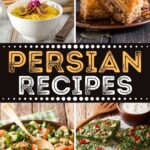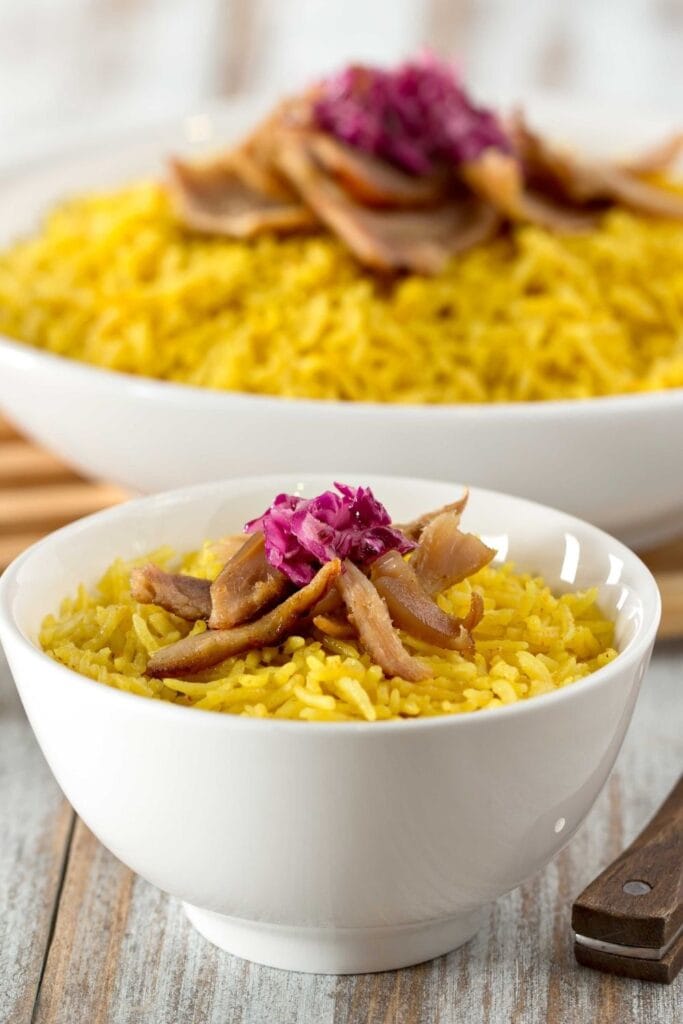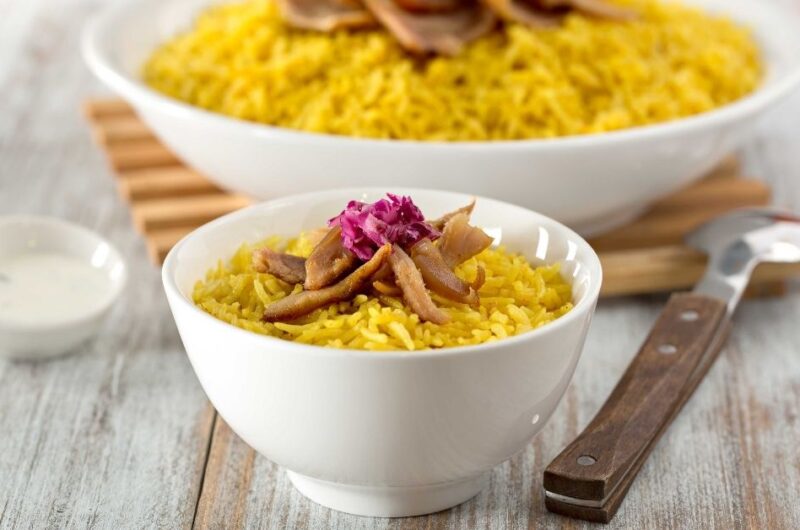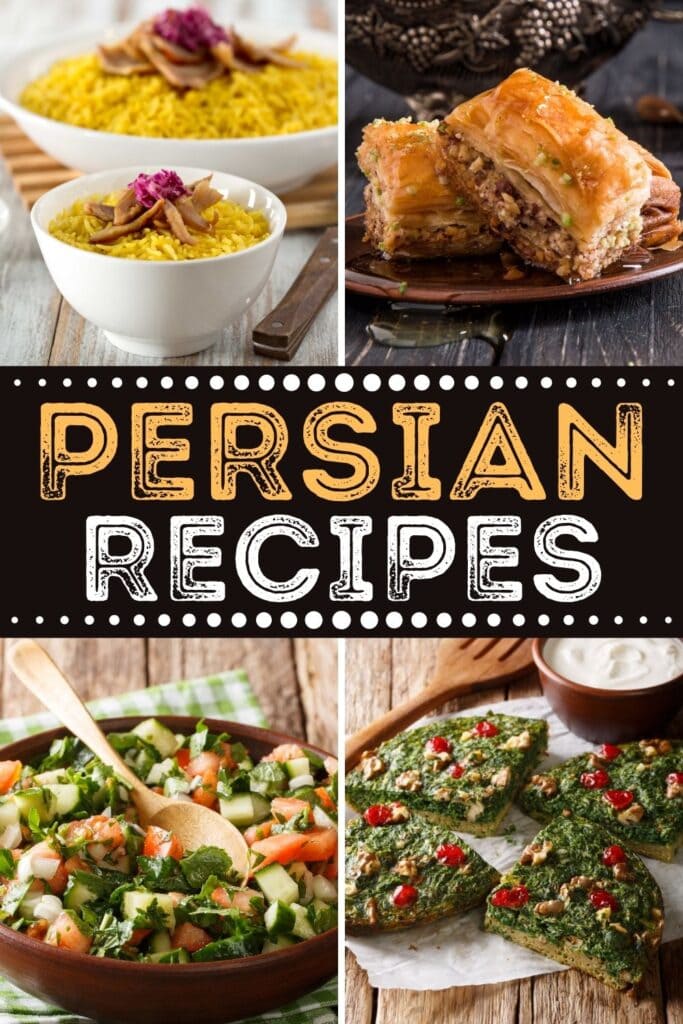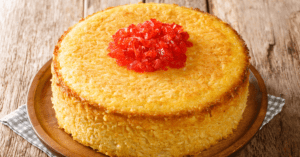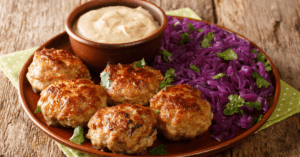Persian cuisine is all about well-balanced flavors, textures, and temperatures. In one meal, you’ll get a combo of sweet, salty, and sour, crunchy and tender, and hot and cold. Somehow, the different components create one harmonious meal. Rice is a crucial part of Persian cuisine. No meal is complete without it. Fresh herbs, spices, and dried fruit are also widely used. In this collection of recipes, you’ll learn how Iranians incorporate these ingredients into their everyday cooking. Treat your taste buds to the fantastic flavors of Persian cuisine! This list has you covered from appetizers to dessert.
1. Persian Saffron Rice
At the heart of every Persian meal is polo or rice, which is why it goes on the top of our list. Aromatic basmati is seasoned with spices, cooked in yogurt, eggs, and oil, and layered with tart barberries. Giving it a lovely golden hue is the sweet, earthy, and rather expensive saffron. Now, understand that polo is not as good without the tahdig – a crisp crust formed at the bottom of the pot during cooking. This recipe knows what tahdig is all about. Aside from its flavor and color, it’s that amazing crunchy crust that makes it stand out.
2. Fesenjan (Pomegranate Walnut Stew)
Fesenjan is a warming stew eaten in the winter. This stew primarily features pomegranate molasses or juice and ground toasted walnuts. Lentils give it heft, while turmeric and cinnamon add warmth. It may seem strange, but the combination of sweet and tart pomegranates and nutty walnuts create a beautiful harmony. The stew is already hearty as it is, but it can also be topped with jasmine rice for a heartier meal.
3. Kuku Sabzi
Kuku is Persian for frittata. It comes in many forms, but this variety is one of the most beloved. Sabzi means herbs, and as you can probably tell, they’re the reason this frittata is wickedly green. Parsley, cilantro, dill, scallions, the list goes on and on. Besides the color, the medley of herbs also gives this frittata a refreshing flavor. Spices cardamom, cumin, and cinnamon add a nice kick, to boot. Toasted walnuts and chopped cranberries add texture and color.
4. Persian Chicken Kebabs
Who can say no to perfectly grilled chicken skewers? I certainly can’t! This Persian masterpiece is a favorite in my household. What makes these kebabs extra special is the marinade – a delicious blend of mayonnaise, lemon juice, onions, garlic, and spices. Bathed in the mixture for 24 hours, the chicken absorbs all the lovely flavors, resulting in kebabs that are one-of-a-kind. Apart from the chicken, large chunks of red onions and bell peppers are threaded onto the skewers to complete the ensemble.
5. Shirazi Salad
Shirazi salad is another staple of every Iranian meal. It’s like a Greek salad, only 10 times more flavorful. Cucumbers, tomatoes, bell peppers, and onions, are tossed with a lime and olive oil dressing. Shirazi salad is as simple as can be, but the flavor and texture are spot on. What makes this salad a cut above the rest are the herbs and spices that go into the dressing. Loaded with fresh parsley, cilantro, dill, and mint, the dressing is in a league of its own.
6. Mast o Khiar (Persian Yogurt Cucumber Dip)
Mast o Khiar is a light and refreshing dip made of yogurt and cucumber. It’s so versatile, it can be served as an appetizer with chips and pita bread, or as a sauce to main dishes such as ghormeh sabzi (herb stew) and kabab koobideh (lamb or beef kebab). The beauty of this delicious dip is that it only calls for two ingredients. As you may have guessed, they’re yogurt and cucumber. Seasoned with salt and pepper, and maybe a bit of dried mint, your dip is ready to be dipped into.
7. Persian Yogurt Drink
Yogurt is a common ingredient in many Persian dishes, but it’s also widely used to make beverages. Ayran is a refreshment made of salted yogurt. The combination of salty and tangy takes a bit of getting used to, but once you do, you’re hooked for life. This thick and luscious drink is the perfect thirst quencher for your Iranian meal. The best part is, it’s a cinch to make. You’ll only need yogurt, salt, and water!
8. Persian Baklava with Walnuts and Rosewater
Now, off to my favorite part of the meal: dessert. Baklava is probably the most popular dessert in Middle Eastern cuisine, and I 100% get it. Layers of crispy and flaky pastry with chopped toasted nuts and syrup in between create the most phenomenal combination of flavors and textures. The added rose water, cardamom, and brown butter make this baklava truly exceptional. You’ll think it’s such a complicated recipe, but thanks to store-bought phyllo pastry, it’s surprisingly easy.
9. Persian Tea
Green tea may be the healthiest option, but it comes to relaxing and aromatic tea leaves, it’s team chai all the way. Chai or black tea is the go-to morning, afternoon, and evening beverage for Persians. Their choice of leaves includes Ceylon, Darjeeling, English Breakfast, and Earl Grey. This recipe teaches not only how to brew a perfect pot of chai tea, but also lets you in on a cool technique on how to achieve a two-colored look.
10. Persian Rice Cookies
Cookies are a universal dessert. They’re as much loved in Iran as they are in the US. Give these rice cookies a try, and you’ll understand why. These cookies are commonly served during Nowruz, or Persian New Year, and other special occasions. Delicate and crumbly with just the right amount of sweetness, these treats are definitely holiday-worthy. There are many variations to the cookies. For instance, some add butter to the dough for richness, while others prefer oil for moisture. Rosewater or cardamom can also be added for flavor. However they may vary, all recipes include rice flour, sugar, and eggs as the basic ingredients. Click on a star to rate it!
Average rating 4.5 / 5. Vote count: 12 No votes so far! Be the first to rate this post.
Share on social media: Let us improve this post!

